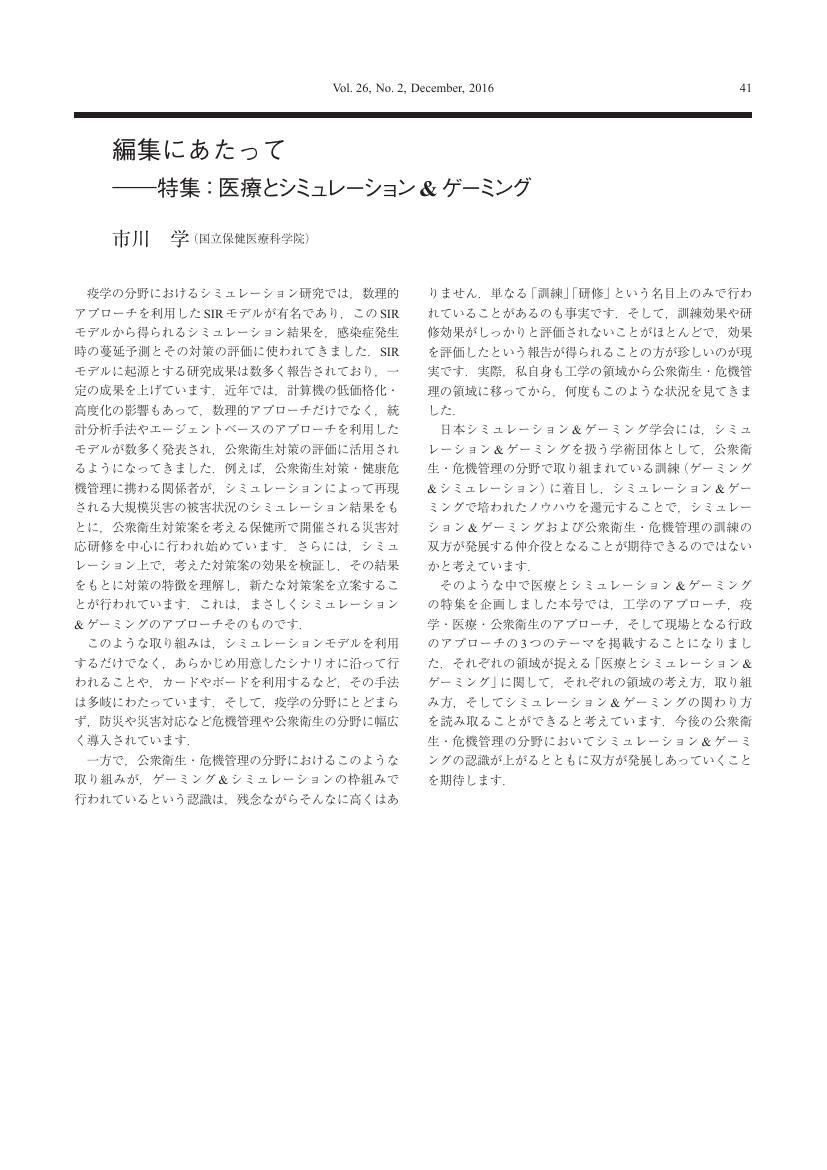9 0 0 0 OA 災害時における保健医療支援活動プログラムとマネジメント
- 著者
- 市川 学 石峯 康浩 近藤 祐史 出口 弘 金谷 泰宏
- 出版者
- 一般社団法人 国際P2M学会
- 雑誌
- 国際P2M学会誌 (ISSN:24320374)
- 巻号頁・発行日
- vol.12, no.1, pp.21-35, 2017 (Released:2017-10-30)
- 参考文献数
- 12
- 被引用文献数
- 2
地震に代表される自然災害の多いわが国では、災害発生時に被災地の医療を支援するため、避難者の健康を管理するために、DMAT・DPAT・DHEATなどに代表される保健医療支援活動従事者が、被災地において支援活動を行う。本研究では,発災直後から復興期にかけて保健医療支援活動従事者が、どのように組織され、どのような活動をどのように行なっているかを論じる。また、近年では、保健医療支援活動を支える情報技術も整備されつつあり、情報を利活用する災害時の保健医療支援活動についてマネジメントの視点を交えて説明する。
8 0 0 0 OA 理・工・医学の連携による災害医療デジタルツインの開発と医療レジリエンスの再構築
- 著者
- 越村 俊一 江川 新一 久保 達彦 近藤 久禎 マス エリック 小林 広明 金谷 泰宏 太田 雄策 市川 学 柴崎 亮介 佐々木 宏之
- 出版者
- 東北大学
- 雑誌
- 基盤研究(S)
- 巻号頁・発行日
- 2021-07-05
リアルタイムシミュレーション,センシングの融合による広域被害把握,被災地内外の人の移動と社会動態把握,医療需要および被災地の医療活動状況を入力としたマルチエージェントシミュレーションで構成する仮想世界でのwhat-ifの分析を通じて,物理世界となる被災地での災害医療チームの活動を支援するための「災害医療デジタルツイン」を構築する.災害医療の最前線で活動する研究者との協働を通じて,南海トラフ連続地震により連続して来襲する津波のリスク下において,医療システムの一部の機能が一定期間低下しても,被災地内外の災害医療の機能を速やかに回復できる医療レジリエンスの再構築を先導する.
- 著者
- 石西 正幸 市川 学 田沼 英樹 出口 弘 金谷 泰宏
- 出版者
- 一般社団法人 システム制御情報学会
- 雑誌
- システム制御情報学会論文誌 (ISSN:13425668)
- 巻号頁・発行日
- vol.27, no.7, pp.319-325, 2014-07-15 (Released:2014-10-15)
- 参考文献数
- 13
- 被引用文献数
- 1
This paper aims to propose a risk assessment method on countermeasure against infectious disease with high fatality rate using social simulation. We constructed a novel model which are able to visualize social vulnerability against outbreak of infectious disease such as smallpox. In this model, disease state transition of smallpox, infection process, social structure, human activity, social countermeasure, simulation condition that include parameters, and simulation results are described. We evaluate the social protection policies by an agent-based model using Spot Oriented Agent Role Simulator (SOARS). This model is able to visualize the risk of social vulnerability against smallpox and social vulnerability is different among generations.
1 0 0 0 OA 編集にあたって―特集:医療とシミュレーション&ゲーミング
- 著者
- 市川 学
- 出版者
- NPO法人 日本シミュレーション&ゲーミング学会
- 雑誌
- シミュレーション&ゲーミング (ISSN:13451499)
- 巻号頁・発行日
- vol.26, no.2, pp.41, 2017-12-25 (Released:2019-09-12)
1 0 0 0 OA 感染症実用シミュレーションにおける仮想都市構築法の違いによる結果への影響分析
- 著者
- 市川 学 出口 弘
- 出版者
- 公益社団法人 計測自動制御学会
- 雑誌
- 計測自動制御学会論文集 (ISSN:04534654)
- 巻号頁・発行日
- vol.49, no.11, pp.1012-1019, 2013 (Released:2013-11-27)
- 参考文献数
- 11
This paper describes specific points of simulation models in the urban simulation domain. Most of the agent-based models in this domain are made with using the cellular automaton methodology, but lack of considering life spaces, such as houses, offices, schools and so on. In this paper, we make two similar infection models. One is based on the cellular automaton and the geographic information system without considering life spaces, while the other is with life spaces considered. From simulation results, we find that simulation results become significantly different due to the differences between ways of model construction, and realize that life spaces are very important for some social phenomena that focus on interactions between human and human, and human and spaces, such as a spreading infection phenomenon.
1 0 0 0 OA 社会システムの研究動向5—研究のためのツール— シミュレーション言語の特徴と比較
- 著者
- 市川 学 後藤 裕介
- 出版者
- 公益社団法人 計測自動制御学会
- 雑誌
- 計測と制御 (ISSN:04534662)
- 巻号頁・発行日
- vol.52, no.7, pp.595-600, 2013-07-10 (Released:2018-04-25)
- 参考文献数
- 9

